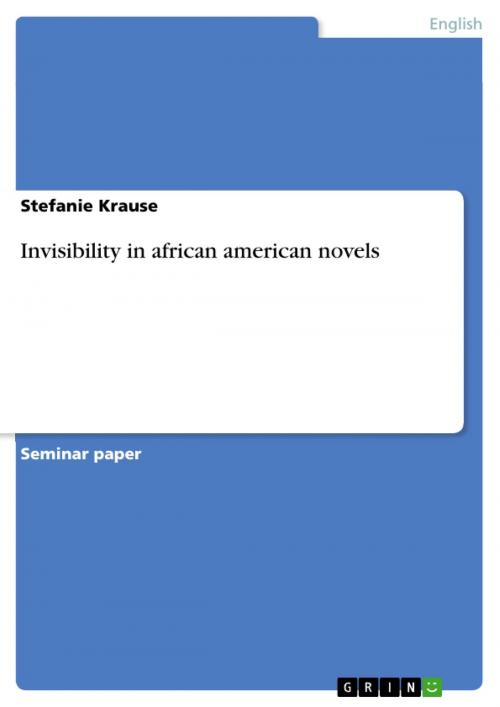| Author: | Stefanie Krause | ISBN: | 9783638592161 |
| Publisher: | GRIN Publishing | Publication: | January 14, 2007 |
| Imprint: | GRIN Publishing | Language: | English |
| Author: | Stefanie Krause |
| ISBN: | 9783638592161 |
| Publisher: | GRIN Publishing |
| Publication: | January 14, 2007 |
| Imprint: | GRIN Publishing |
| Language: | English |
Seminar paper from the year 2006 in the subject American Studies - Literature, grade: 1,7, University of Mannheim, course: African American Novels, 18 entries in the bibliography, language: English, abstract: Blindness is a topic in many African American novels published in the middle of the 20th century. However, this does not mean that black protagonists are over-averaged disabled. The inability of seeing refers more to a special type of blindness: a psychical one. This kind of disablement is 'a matter of the construction of [the] inner eyes, those eyes with which [one] look[s] through [the] physical eyes upon reality' (Ellison, Ralph. Invisible Man. London: Penguin Books, 1965. p.7). It is a way of refusing to recognise people and their character traits, which African Americans were often confronted with. This ignorance of the - mainly - 'white' society is picked out as a central theme in many African American novels and, therefore, it will be the topic of this publishing. To prove this thesis, the following analysis will examine some example scenes from Ralph Ellison's 1952 published novel Invisible Man. As one single book is not sufficient to establish a thesis for a whole genre, additionally scenes from Richard Wright's 1940 published novel Native Son and Ann Petry's 1946 published novel The Street will be briefly analysed. Even though a comparison between all three novels would have been interesting as well, this work will take its main focus on one single novel, to go as deeply into detail as the limited space allows, instead of giving only a cursory overview of different works. For the same reason, this work will not contain a summary of the discussed novels as these are expected to be known. As the title of the work probably raises the expectation of an analysis of the physical blindness, this topic will be worked out in the second chapter, concentrating on Invisible Man, and, later on, briefly on Native Son. The attempts to point out its metaphorical meaning and to connect this with the psychical blindness will be made. The main part of the analysis will be the examination of the psychical blindness that affects the main protagonist as well as the minor characters of Invisible Man. A closer look will be taken at the repeated eye-metaphors as well as at the function of the telling names. Referring to the title of the book, the attempt to answer the question, if invisibility is a result of blindness, will be made. To prove that Ellison's novel is not the only one that deals with the topic of blindness, the fourth and fifth chapter will deal with Petry's and Wright's novels that were published in the same period.
Seminar paper from the year 2006 in the subject American Studies - Literature, grade: 1,7, University of Mannheim, course: African American Novels, 18 entries in the bibliography, language: English, abstract: Blindness is a topic in many African American novels published in the middle of the 20th century. However, this does not mean that black protagonists are over-averaged disabled. The inability of seeing refers more to a special type of blindness: a psychical one. This kind of disablement is 'a matter of the construction of [the] inner eyes, those eyes with which [one] look[s] through [the] physical eyes upon reality' (Ellison, Ralph. Invisible Man. London: Penguin Books, 1965. p.7). It is a way of refusing to recognise people and their character traits, which African Americans were often confronted with. This ignorance of the - mainly - 'white' society is picked out as a central theme in many African American novels and, therefore, it will be the topic of this publishing. To prove this thesis, the following analysis will examine some example scenes from Ralph Ellison's 1952 published novel Invisible Man. As one single book is not sufficient to establish a thesis for a whole genre, additionally scenes from Richard Wright's 1940 published novel Native Son and Ann Petry's 1946 published novel The Street will be briefly analysed. Even though a comparison between all three novels would have been interesting as well, this work will take its main focus on one single novel, to go as deeply into detail as the limited space allows, instead of giving only a cursory overview of different works. For the same reason, this work will not contain a summary of the discussed novels as these are expected to be known. As the title of the work probably raises the expectation of an analysis of the physical blindness, this topic will be worked out in the second chapter, concentrating on Invisible Man, and, later on, briefly on Native Son. The attempts to point out its metaphorical meaning and to connect this with the psychical blindness will be made. The main part of the analysis will be the examination of the psychical blindness that affects the main protagonist as well as the minor characters of Invisible Man. A closer look will be taken at the repeated eye-metaphors as well as at the function of the telling names. Referring to the title of the book, the attempt to answer the question, if invisibility is a result of blindness, will be made. To prove that Ellison's novel is not the only one that deals with the topic of blindness, the fourth and fifth chapter will deal with Petry's and Wright's novels that were published in the same period.















